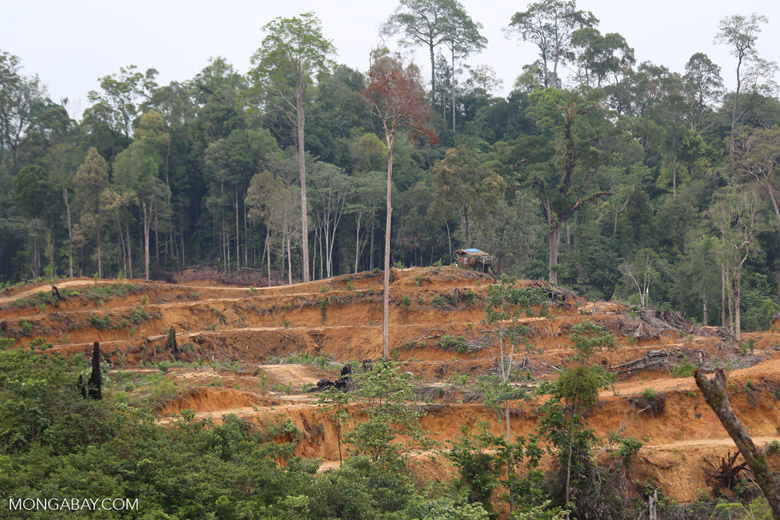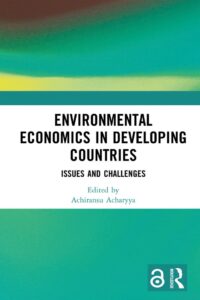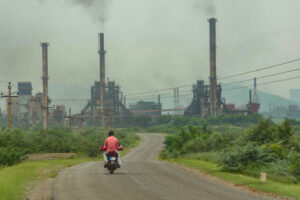Book Review: The Linkages That Could Make Or Break Post-Pandemic World
Jan 3, 2024 | Pratirodh Bureau
Clearing for a new oil palm plantation in Indonesia. The global demand for palm oil was the driver for large-scale land-use change that led to the spillover of the Lassa virus (Photo by Rhett A. Butler/Mongabay)
- ‘Environmental Economics in Developing Countries: Issues and Challenges’ is a collection of academic papers by environmental economists from the South Asian region.
- Ecosystems are like capital assets providing more than a 19% rate of return, but they remain unacknowledged as their contributions do not get captured by the conventional metrics of the economy, writes S. Gopikrishna Warrier in his book review.
- The COVID-19 was a reminder, if we had considered it to be one. The world is back at the growth model with a vengeance since the fear lifted.
 It was a time like what we had never faced earlier in our lifetimes. Today we are back living as if the COVID-19 pandemic never happened. Lost in between is a lesson that we have refused to learn – a lesson on the interlinkages between health, environment and economics. It started with zoonosis – an infectious disease moving from an animal to humans. It spread fast and with high morbidity, causing millions of deaths.
It was a time like what we had never faced earlier in our lifetimes. Today we are back living as if the COVID-19 pandemic never happened. Lost in between is a lesson that we have refused to learn – a lesson on the interlinkages between health, environment and economics. It started with zoonosis – an infectious disease moving from an animal to humans. It spread fast and with high morbidity, causing millions of deaths.
The world economy has still not recovered from its economic impact. In 2020, the first year of the crisis, the global economy is estimated to have shrunk by 3.5% and employment fell by 114 million jobs.
Caught between the warp and weft of globalisation, India suffered from the severe economic uncertainty of the pandemic. When the national lockdown – with a few hours’ notice – was announced in India, millions of those who had migrated within the country in search of employment had to walk back to their homes in their villages. It was an event unseen since the great migration of the Partition in 1947.
If there was anything that saved livelihoods that year, it was the farming sector supported by a normal monsoon. With the second wave of infections hitting the urban dwellers and even the economically well-off, there was hope that there could be an introspection with the unsustainable growth-led economic model. That was, however, not to be, with every activity returning with gusto once the face masks started disappearing.
‘Environmental Economics in Developing Countries: Issues and Challenges’, edited by Achiransu Acharyya is a collection of academic papers by environmental economists from the South Asian region that explore these interlinkages, especially as they unravelled during the COVID-19 pandemic. The volume is in honour of Professor Rabindra Nath Bhattacharya, who introduced environmental economics to students and researchers in the 1980s. Working at universities in West Bengal, he was also a mentee at the South Asian Network for the Development of Environmental Economics (SANDEE).
Acharyya describes environmental economics as the discipline that can bring together developmental and environmental concerns. “Developing countries face a big challenge. On the one hand, they must improve the standard of living of their people, many of whom are poor; on the other, they must abide by the norms of carbon emission and development goals. Environmental economics can play a crucial role in achieving both.”
The Linkages Broke
The COVID-19 pandemic itself is something that happened because the linkages were broken, write Pushpam Kumar, Amelia Holmes and Samia Islam. “Well-established interdisciplinary research demonstrates that human, animal, and ecosystem health are inextricably linked. Infectious diseases and a vast diversity of pathogens naturally exist in ecosystems, and they contribute to biodiversity and the system’s long-term dynamic stability. In the 20th Century particularly, an unprecedented dramatic decline in biodiversity and equally dramatic increases in people and domestic or farmed animals had presented an increased opportunity for pathogens to pass from the biophysical environment with wild and domestic animals, in human communities and across the world.”
When livestock are reared near forest tracts, there are chances for pathogens to spill over from wild to domestic animals, followed by transmission to humans. The use (and overuse) of anti-microbial agents by humans and their livestock reduces the resistance to such pathogen attacks for both humans and animals. In already stressed ecosystems, the impact of disease outbreaks can trigger cascades. Climate change can add to these ecosystem stresses and also bring new pathogens into play.
Kumar et al. quote from the study developed for the U.K. Treasury Department by eminent environmental economist Sir Partha Dasgupta, as what was recommended as the blueprint for post-COVID recovery. The Dasgupta Review highlighted the “importance of biodiversity for our health and that of the global economy, as well as the need for the human enterprise to live within the safe operating space of the biosphere.”
The economic growth since the 1950s was at the cost of biodiversity, climate and nature in general. Biological diversity gives stability to natural systems. Ecosystems are like capital assets providing more than a 19% rate of return, but they remain unacknowledged as their contributions do not get captured by the conventional metrics of the economy. COVID-19 recovery, the Dasgupta Review had recommended, should be within the limits of the regenerative capacity of the earth’s ecosystems.
Post-Second World War Process
Acharyya recapitulates economic history after the Second World War for the developed and developing countries and how the discipline of environmental economics emerged from this process. The widespread destruction that the war caused, combined with the victors’ desire to kick-start their national economies through reconstruction inside and outside their countries, led to the growth-based economic model, which continues even now.
It was also the period that the colonial centres could not hold on anymore and many countries in Asia, Africa, and Latin America got their independence starting from the 1940s to the 1960s. Post-colonisation, the urge to develop was not restricted to the developed countries alone. The newly-liberated developing countries cloned the Western model of growth for their economies. Industrialisation happened, with its adverse impacts following close behind. “In this light, during the 1950s, environmental economics was more concentrated on studying the optimal use of resources,” observes Acharyya.
Rachel Carson’s book, Silent Spring, was a wake-up call in 1962. It brought, to the public domain, the ill effects of economic growth and industrialisation. This resulted in many cost-benefit analyses, internalising the external costs. Some studies focused on consumption in addition to production and others on the earth’s carrying capacity.

The Brundtland Commission report of 1987 gave the ideas of sustainable development and inter-generational equity. This led to the inclusion of sustainable development and environmental concerns in the funding priorities of the World Bank and the International Monetary Fund and national policies. Research related to common property resources became popular as globalisation and neo-classical economics caused conflicts. In more recent decades, there has been a trend for developed countries to move their polluting manufacturing industries into developing countries.
Starting with the 1980s, environmental economics was used to understand and deal with climate change issues. After the Kyoto Protocol of 1997, when emissions trading was approved, economic considerations came to the forefront in trying to find the price of carbon. These considerations spread even further after the Paris Agreement of 2015, when every country, big or small, had accepted nationally determined contributions towards emission reduction. Today, an entire school of environmental economics has taken over – green accounting, green bonds, green taxonomy, circular economy, etc.
COVID Was An Opportunity Lost
Kanchan Chopra summarises India’s dilemma in this process. While there is an increased understanding and awareness of the environmental situation, there are strong demands for rapid economic growth in the shorter run.
“Not so long ago, the economic questions requiring urgent attention could safely be studied by excluding nature from formal economic reasoning,” writes Partha Dasgupta in his Foreword to the volume. “At the end of the Second World War, with absolute poverty endemic in much of Africa, Asia, and Latin America, and with Europe in need of reconstruction, it made sense to focus on the accumulation of produced capital (roads, buildings, ports, machines) and human capital (health, education). Unfortunately, continued use of the resulting macro-economic models of growth and development has encouraged us to believe that we can forever bypass nature when we imagine our economic possibilities.”
The COVID-19 was a reminder if we had considered it to be one. The world is back at the growth model with a vengeance since the fear lifted. ‘Environmental Economics in Developing Countries: Issues and Challenges’ bravely tries to bring COVID back into the discussions. But then the volume has just a couple of chapters discussing the pandemic, which is an opportunity lost for the book.
The chapters are written by reputed environmental economists of South Asian origin. Each of the chapters describe the authors’ (and their team’s) research work. Since COVID-19 is one of the two guiding principles for the book (the other being the tribute to Prof. Rabindra Nath Bhattacharya), the pandemic and its inter-relations with both economics and the environment could have been dealt with in greater detail.
(Published under Creative Commons from Mongabay-India. Read the original article here)
